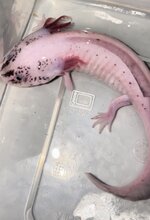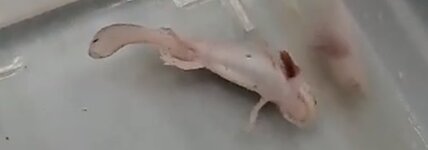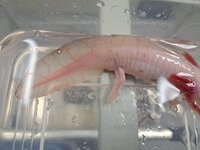Kyting
New member
Dear All,
I'm new to this community and I'm reaching out to the axolotl community in hope that I can help my axolotl. My young axolotl was rescued and was likely kept in high-density conditions before coming to me. Upon arrival, he had saprolegniasis and was initially treated with daily 100% water changes for 2 weeks, which proved ineffective. I then switched to a saltwater bath for a week, which successfully eliminated any visible fungus. He was also prescribe topical enrofloxacin for 2 weeks. Throughout his treatment, though he had on and off veiny (stressed) lines on his tail, he remained active and had a good appetite. However, about a week after the treatment ended, he began to display abnormal behavior. He seemed eager to eat, but it seems to me that he was unable to open his mouth to bite the food. Despite my attempts with different food sizes and types, he was only able to eat once or twice. Recently, he has been swimming erratically and even turning himself over. His toes, previously grey, have now turned black. I continue to perform daily 100% water changes. The levels of ammonia, nitrate, and nitrite are all at 0. The water temperature is 18 degrees Celsius, and the water is dechlorinated. I’ve also observed that he has a new black dot on his tail, but I couldn’t tell if it is because he is leucistic by nature and hence deemed normal.
The last 2 photos attached are taken during his first treatment. the first photo (blurred) were taken today. Apologies for the poor quality.

I'm new to this community and I'm reaching out to the axolotl community in hope that I can help my axolotl. My young axolotl was rescued and was likely kept in high-density conditions before coming to me. Upon arrival, he had saprolegniasis and was initially treated with daily 100% water changes for 2 weeks, which proved ineffective. I then switched to a saltwater bath for a week, which successfully eliminated any visible fungus. He was also prescribe topical enrofloxacin for 2 weeks. Throughout his treatment, though he had on and off veiny (stressed) lines on his tail, he remained active and had a good appetite. However, about a week after the treatment ended, he began to display abnormal behavior. He seemed eager to eat, but it seems to me that he was unable to open his mouth to bite the food. Despite my attempts with different food sizes and types, he was only able to eat once or twice. Recently, he has been swimming erratically and even turning himself over. His toes, previously grey, have now turned black. I continue to perform daily 100% water changes. The levels of ammonia, nitrate, and nitrite are all at 0. The water temperature is 18 degrees Celsius, and the water is dechlorinated. I’ve also observed that he has a new black dot on his tail, but I couldn’t tell if it is because he is leucistic by nature and hence deemed normal.
The last 2 photos attached are taken during his first treatment. the first photo (blurred) were taken today. Apologies for the poor quality.



